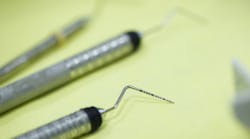From Shrek to Superman: Bridging the gap in patient communication
Patient relationships—and life—can be like a box of chocolates. In the words of Forrest Gump, “You never know what you’re gonna get.” There are patients with whom you easily and effortlessly connect, and there is a positive impact made that is often mutual.
Then there are those whom I call the “others”—those patient relationships that are anything but easy and effortless, and your words seem to fall on deaf ears. There may be an impact, but not one that radiates positivity. The time spent seems to matter only in getting the job done to the best of your ability given the constraints.
Take a moment to think about those situations where you feel you have a connection with the patient. How do you feel at the end of the visit? For me, those interactions involve mutual understanding, respect, two-way conversation, and trust. When I think of my favorite patient interactions, my highlight reel consists of those experiences where I felt heard, appreciated, trusted, and I made a positive difference in a way that mattered to the patient. My sense is that those patients felt similarly about the visit in that they were understood, their time was well spent, and I was their advocate.
Those moments were like a turbo charge to my energy level and passion for dentistry. I always walked away feeling excited about my career, energized to continue to do good work, and filled with a desire to duplicate that experience with other patients. I often joke that I would have the feeling of standing in a Superman pose with a patient napkin as my cape, wind blowing through my hair, and feeling like an empowered force of good! It’s a pretty incredible feeling, right?
Then something would happen. One of the “others” would be in my schedule, and that energy level would deflate almost instantly. The feeling that I was making a difference would quickly be replaced with feelings of being dismissed, defeated, and sometimes even disrespected.
Can you relate to the feeling of doing your very best for a patient in terms of care and education only to have it met with responses like these?
“I just want the regular cleaning” (said after you have delivered incredibly informative patient education regarding periodontal disease).
“I already know how to brush my teeth” (but your observation shows they do not).
“I have soft teeth and I’m a bleeder, so what you are saying doesn’t apply to me. I hate being here and you make my gums bleed.”
Then there are the patients you think you have reached, only to learn at their next visit (or worse, as soon as the dentist enters the room for the exam that same day) that they have no recollection of what was discussed.
The Superman pose I described above would be quickly replaced with feeling like Shrek in the lonely and irritable pre-Fiona days. I felt frustration and resentment. If you have enough of these interactions and they begin to get to you, you can experience the kryptonite of dental professionals everywhere—burnout.
I spent the first 10 years of my career chalking up this elation/deflation phenomenon to its being the nature of the beast of working with people. I called it “dancing with the one who brought you,” meaning we have to make the best of each patient interaction—whether there is easy connection or not; whether they are ready to take what we have to offer or not; whether they value our knowledge and ability or not. We are not going to adore every patient, and some cannot be helped at the level we feel they need or we want. Similarly, we may not be every patient’s “cup of tea,” and they may not be interested or motivated to move forward to better oral health. We must take the bad with the good, do our best, not take it to heart, and hope that the positive encounters outweigh the negative.
Then I learned something. We might have to dance with the one who brought us, but we have far more control over the dance steps than I had realized. We have an opportunity to duplicate those Superman moments with some of the “others,” and we need to approach those conversations differently.
This was when I started to learn and develop a passion for person-centered care, a concept that goes hand in hand with motivational interviewing. The concepts of patient-centered dentistry and motivational interviewing can fill books. For the purpose of this piece, I am referring to a way of being and communicating with a patient that is different from the traditional patient communication models used in health care.
In traditional models, the patient-provider relationship can be described as authoritative, paternalistic, and informative in nature. Providers share information about what they believe to be in their patients’ best interest. Instead of collaboration, it is more of a divided approach, particularly when working with a patient who may be nonreceptive or not ready for what is indicated.1 “The dental treatment room itself, where patients are in a submissive position and the clinicians are in a controlling position, supports these traditional roles. With a focus on technical expertise, dental clinicians may believe that their communications with patients will be based on common sense or are secondary to the provision of successful treatment.”2
Instead of the traditional lecture-style education we provide to patients regarding oral health, patient-centered care includes two-way dialogue. It also uses motivational interviewing (MI), a counseling approach developed in part by clinical psychologists William R. Miller and Stephen Rollnick, which is “a collaborative, goal-oriented style of communication with particular attention to the language of change. It is designed to strengthen personal motivation for and commitment to a specific goal by eliciting and exploring the person’s own reasons for change within an atmosphere of acceptance and compassion.”3
Before you say, “But I have dialogue with my patients all of the time; I don’t lecture,” ask yourself the following:
- Is the patient able to engage when talking about something important, or am I communicating while they are lying in the chair in the middle of treatment?
- Who is doing the majority of the talking? Am I asking open-ended questions for which the patient has to provide more than a yes or no answer?
- Is the patient an active participant when it comes to discussing ideas on how they can implement positive changes?
- Do I understand what is important to the patient and what their barriers to optimal oral health may be?
The spirit of MI is one of collaboration, compassion, evocation, and acceptance. These concepts support true patient-centered care.3 The conversational patient-centered dialogue is focused on more than oral health. It is a style of communicating that is based on curiosity, respectful listening, and eliciting information from the patient versus “telling them what to do.” It takes into account the patient’s goals, beliefs, obstacles (real and perceived), and the like. The focus is more of a partnership mentality versus a push mentality, which can provide us with a bridge over the gap that can exist between ourselves and even the most challenging of patients. The overall style is one of guidance, which incorporates both directing and following. Further, with the patient doing more talking, evidence suggests people are more likely to be persuaded by what they hear themselves say.3
A real-life example
Within seconds of meeting a patient for the first time at an office where I was temping, her angry response when I introduced myself was, “I don’t do x-rays so don’t even ask.” Instead of my former way of addressing the issue (passionately discussing the standard of care, risks, the caries process, why we cannot wait for pain to do necessary diagnostics, explaining that the dentist requires them for proper diagnosis, discussing the potential for dismissal from the practice as it is a liability to treat a patient without proper diagnostics—all of which are true but don’t really matter to—or motivate—most patients), I tried a different communication approach. I also chose not to take her angry refusal personally and saw it as an opportunity to start a conversation based on curiosity and developing better mutual understanding.
I told her that I heard and respected what she was saying and was curious why she was so opposed. After a few questions, I learned that she thought she did not need x-rays because her teeth were “fake.” She was under the impression that her full-mouth reconstruction of crowns and bridges were “not real teeth and can’t get cavities.”
I understood why she thought that way, and I stated I would have thought the same prior to entering the dental profession. I asked if I could share something with her. She was receptive while I showed her the old x-rays we had on file for her. We looked at where her teeth were under the crowns and discussed how decay can happen there. I also shared that we cannot see those areas clinically, and where her teeth were endodontically treated, she would likely not experience signs or symptoms that something was breaking down. She was running the risk of losing teeth or “losing her investment,” and we talked about how losing part of a bridge can be akin to pulling a string on a sweater in that so much of her work was connected.
I acknowledged that her teeth must be important to her to have spent so much time and money on them and commended her for coming religiously for recare. I asked how she was feeling about what we talked about.
She wondered how she never realized this before, appreciated the explanation, and asked, “Can we take whatever x-rays are needed today? I’m never saying no to those again.”
A patient relationship that started with a disconnect that spanned the last five years of her hygiene visits in that office became one of mutual understanding, trust, and feeling value for the services and care we provide as professionals. Further, the liability of outdated diagnostics and having to dismiss the patient were no longer considerations. Instead of my telling her what she needed, she was telling me what she wanted, which was exactly what she needed!
You might be asking, “How am I supposed to add this on to all the other things that I need to do during an appointment, particularly as I work through the challenges of practicing during COVID-19?” These conversations don’t have to happen all at once. I described it to a colleague recently by using the analogy that it’s like eating an elephant. You manage it one bite at a time! Also, the more you do it, the more you become efficient and effective with it.
My advice is to start with just one patient and just one technique that might be something different than what you currently are doing, particularly with a patient with whom you feel there is a disconnect. The following is a list of just a few of the many strategies you can try as you begin to implement more of this type of dialogue into your practice.
Focus more on conversations versus one-way information sharing
Instead of sharing information, ask open-ended questions to evoke more information and thought from your patient. Use the medical, dental, and social histories and your assessment data to ask more questions that can help you connect the dots and engage the patient.
- Ask: “What changes have you noticed in your mouth since adding your new medications?”
- Ask: “How has your arthritis affected your ability to care for your teeth?”
- Ask: “What are you expecting from your visit today? Is there anything that you feel I should know that we didn’t cover today? How can we best work together?”
- Instead of questions like: “How many times per day do you brush, and do you floss?” say: “Tell me how you take care of your teeth.”
- I used to ask: “Do you eat a lot of sugary foods or drinks?” Patients would say no, but their oral condition often suggested otherwise, likely because not all patients understand what types of foods and drinks cause caries and erosion. Consider changing the questions to: “What are your favorite things to drink? What does your typical diet consist of? What was in your lunchbox today?” These questions produce far more accurate answers and open a dialogue for sharing additional information through a conversation that can be more meaningful and impactful to a patient.
- Ask the patient about their goals for their oral health and tie relevant information back to their goals. “I remember you said your goal is to avoid costly dental treatment. How are your current choices helping you achieve that goal? I’m concerned because avoiding the necessary periodontal therapy is in contrast to your goal. What is holding you back?”
Remember, you don’t have to ask all of these questions at once! Pick one or two that may be relevant to that particular visit or a recurring obstacle with the patient.
Use active listening skills
Reflect on what is being said instead of thinking of your next question. Clarify what you hear the person saying to provoke thought and empathize with what you hear.
- “What I am hearing you say is that you are concerned about getting cavities, but you aren’t ready to give up soda yet. Change can be a challenge, but I know you don’t want to do more restorative work. What can you do to balance this?”
- “It seems like working second shift is making it more difficult for you to follow a routine at home. That sounds really challenging. Can you think of a way this could work for you?” If the person is having difficulty answering, you could say, “Would you mind if I share with you what’s been helpful for other patients and we can see if some of that might work for you?”
- “You shared that you are concerned about your breath and that your teeth appear longer. Can I share with you how your gum health is playing into this and some concerns I have?”
- Weave curiosity (instead of trying to convince) throughout the appointment.
Plant a few seeds at a time versus an entire garden
This was one of the hardest concepts for me to adopt. I wanted to share everything with every patient all the time. What I learned was this “information dump” made me feel good about the appointment—like I’d covered all the bases—but by sharing so much, my patient got little to no information out of it. They were often overwhelmed, tuned out, and drowning in a tsunami of dental education. The end result was that both the patient and I would be frustrated due to a lack of real communication. It has been said that information is “getting out,” where communication is “getting through.”
- Focus on one or two pieces of information or goals at a time.
- Document what you have discussed so that you can resume the conversation next time you speak with the patient. Ask: “You have committed to before-bedtime brushing, doing it earlier in the evening before you fall asleep on the couch. Do I have your permission to review this with you the next time we talk?”
- Similarly, if the patient has set a goal, it can be helpful for them to write that goal down for themselves and keep it somewhere they will be reminded of it regularly. A note on the bathroom mirror or a reminder in their phone has been an effective tool for many of my patients.
- Something as simple as saying “I’m really proud of you” can go a long way with patient motivation.
Final thoughts
Just as we want to be heard and respected, patients feel the same way. Changes to the communication dynamic can benefit both providers and patients. A 2014 study published by the American College of Obstetricians and Gynecologists on effective physician-patient communication showed that the use of patient-centered interviewing, caring communication skills, and shared decision making improves patient-physician communication and promotes better health outcomes.4 Further, it promotes better patient experiences and better clinician experiences, which means more of those Superman moments for both of you!
It is important to share that this way of communication still comes with boundaries based on ethical and legal responsibilities. If we cannot get past a barrier that impacts what we know to be a standard of care, or safe and respectful patient relationships, decisions must be made. Sometimes it may take a patient longer than others to shift. Others may never shift. The dismissal policy is something that must be discussed and clearly communicated within an office. I recommend you align yourself with offices with a similar philosophy to your own.
During your next day at the office, I encourage you to find one opportunity (or more!) to raise a patient’s curiosity or concern, to help a patient achieve a “lightbulb” moment when they understand something in a different way that promotes a healthier outcome, and to try new skills to bridge those gaps that can be so frustrating to patients and clinicians alike. There are many resources available to provide you with additional information. I highly recommend the references cited below, and there are several good resources available online as well.
As I became more proficient, what I learned was that some of the “others” became some of my most rewarding experiences of all. In the words of children’s television personality Mr. Rogers, “It’s not the honors and the prizes and the fancy outsides of life which ultimately nourish our souls. It’s the knowing that we can be trusted.”
References
- Rosengren DB. Building Motivational Interviewing Skills: A Practitioner Workbook. The Guilford Press; 2018.
- Ramseier CA, Suvan JE, eds. Health Behavior Change in the Dental Practice. Wiley-Blackwell; 2010.
- Miller WR, Rollnick S, eds. Motivational Interviewing: Helping People Change. The Guilford Press; 2012.
- Effective patient–physician communication. American College of Obstetricians and Gynecologists. Obstet Gynecol. 2014;123:389-393. www.acog.org/clinical/clinical-guidance/committee-opinion/articles/2014/02/effective-patient-physician-communication.
About the Author

Julie Whiteley, BS, RDH
Julie Whiteley, BS, RDH, is certified in human resources. She holds degrees in business administration and dental hygiene and has worked extensively in both fields. She is on the faculty of Massachusetts College of Pharmacy and Health Sciences University in Boston. Julie bridges her knowledge and experience from business, clinical hygiene, and teaching to deliver information and programs that enhance dental practices. Contact her at [email protected].


